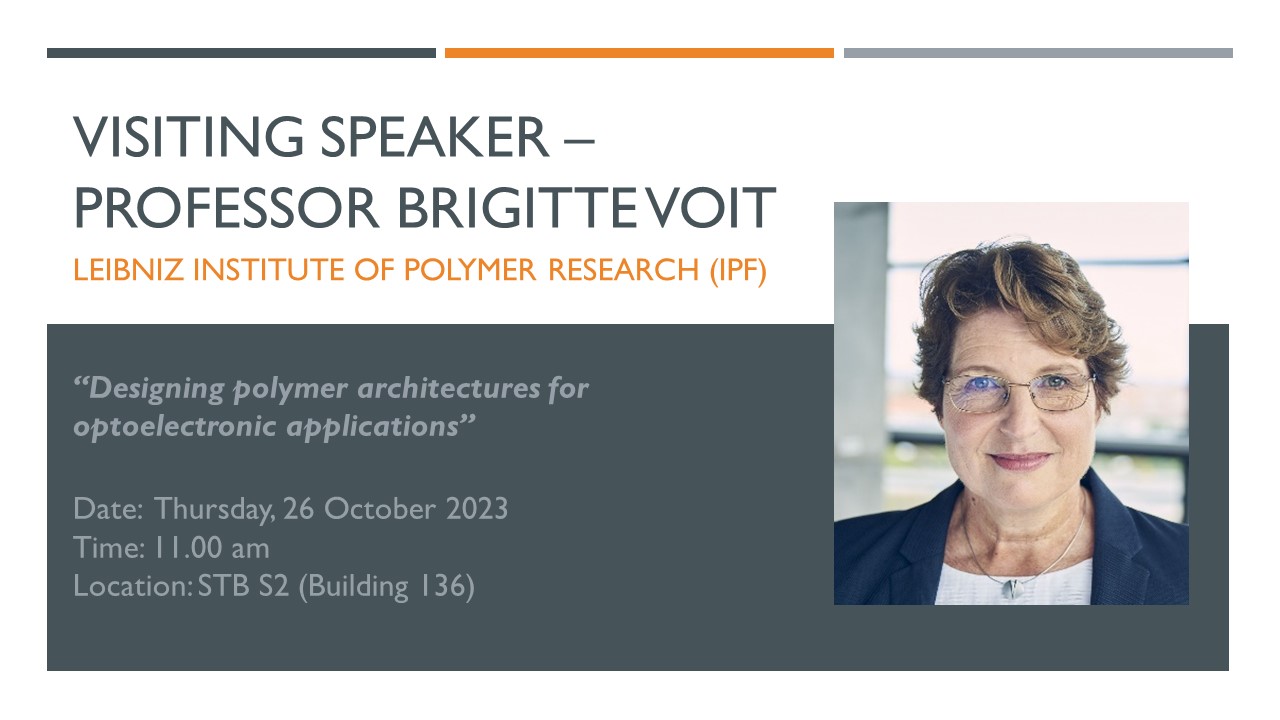Visiting Speaker - Professor Brigitte Voit (Leibniz Institute of Polymer Research)
Title: Designing polymer architectures for optoelectronic applications
Speakers
Content navigation
Description

Designing polymer architectures for optoelectronic applications
Abstract
The microelectronics industry and especially the organic/flexible electronics industry continue to demand new innovative polymeric materials. Examples of newly developed polymers of high charge mobility as very promising, printable and stable active materials of printed organic field effect transistors (OFETs) will be shown. Controlled polymerization techniques like Kumada-Catalyst-Transfer-Polycondensation allow to prepare polymeric semiconductors with precision structure under mild conditions with very low catalyst amount, resulting in very high molar mass products with low defects and improved performance, as well as being able to design the architecture and end group. In addition, synthetic procedure have been improved for various C-C coupling reactions to prepare e.g. fluorene, carbazoles, diketopyrrolopyrrole (DPP) or naphthaline diimide based structures with improved performance, and adding features like crosslinking ability, reactive end functionality, and improved processing properties. Examples will be given for effective crosslinking by temperature and UV for polycarbazoles having azide and alkyne groups, and for covalently binding dopants to polymeric semiconductors.
Highly aromatic polymers exhibit usually high thermal and mechanical stability but also limited solubility and processability. Introducing branching can solve this limitation allowing to combining excellent material properties with the needed requirements for integration of these materials into application. Hb polyphenylenes prepared through Diels-Alder cycloaddition reactions have been prepared for their use as dielectric materials in MOFET as well organic field effect transistors. High refractive index (HRI) materials play a very important role in optoelectronic applications. We developed a class of aromatic HRI hb polymers based on an easily scalable A2+B3 approach making use of thiol-yne addition reaction. Fully soluble materials of reasonable molar masses and good film forming properties could be obtained which showed very high refractive index data up to 1.79 at 589 nm. High performance state-of-the-art phosphorescent red OLED external quantum efficiencies (EQE) of over 20 % having our hb polyvinylsulfides as polymeric out-coupling layer. Thermally activated delayed fluorescence (TADF) materials are discussed as one of the most promising future OLED materials.
Biography
Brigitte Voit received her PhD in Macromolecular Chemistry 1990 from University Bayreuth, Germany. After postdoctoral work in 1991/1992 at Eastman Kodak in Rochester, USA, she joined Technische Universität München. After habilitation in 1996, she was appointed 1997 full professor for "Organic Chemistry of Polymers“ at Technische Universität Dresden as well as head of the Institute of Macromolecular Chemistry at the Leibniz Institute of Polymer Research (IPF) Dresden. From 2002 to 2022 she was also Scientific Director of IPF. At TU Dresden she is member of the Center for Advancing Electronics Dresden (cfaed) and the Dresden International Graduate School for Biomedicine and Bioengineering (DIGS BB). She is active in the European Polymer Federation (president 2014/2015), member of acatech, and holder of the Staudinger Award.
Her scientific interest is in functional polymer architectures and responsive polymers for e.g. biomedicine, smart systems and organic electronics.
Location
STB S2 (Building 136)
